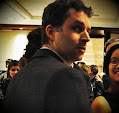I find Drawball interesting because it provides a visualization of community dynamics. You see, some people go there and try to create nice things. Others are bent on destroying any and all nice things. People team up, so they can think big - and draw big. There are (good and evil) mobs. There are turf wars. There is drama.
The action on the ground is perhaps best described as ferocious pixel warfare. If you're wondering what the process looks like from 30,000 feet, watch this (there's a better quality video here):
I believe Drawball One is by now pretty much covered in protected areas that no one can overwrite, as a result of a preservation effort by the site's mastermind; On Drawball Two, however, it's the wild wild west.
 Okay. On to our experiment. First we drew and colored in an "impossible triangle" of modest size. This didn't take too long and was not really difficult. Surprisingly, maybe owing to its small size, it stayed nice and clean for a few days.
Okay. On to our experiment. First we drew and colored in an "impossible triangle" of modest size. This didn't take too long and was not really difficult. Surprisingly, maybe owing to its small size, it stayed nice and clean for a few days. Then we got started on something more ambitious: a fractal shape called a Sierpinski gasket. I picked this shape because it could grow without bounds from a small seed, and I figured its simplicity would make it relatively easy to repair, even for someone who didn't know exactly what it was. You can see the initial effort to the right.
Then we got started on something more ambitious: a fractal shape called a Sierpinski gasket. I picked this shape because it could grow without bounds from a small seed, and I figured its simplicity would make it relatively easy to repair, even for someone who didn't know exactly what it was. You can see the initial effort to the right.Very quickly we had a budding replica of the seed, and one of the largest solid black areas on drawball. I think someone working alone would have taken a few days to do this, taking ink refill delays into account.

By the next day we had a pretty nice start. The shape had grown to a size that was noticeable on the whole-ball view (without magnification).
And that's when some vandals noticed us. They actually organized raids against our glorious gasket. Ink limitations mean raids are the only way to get any serious harm done quickly on Drawball. The bottom picture shows what the gasket looked like on day three. Nature abhors a vacuum, and those empty triangles obviously just looked too tempting.

Now, there is no revert button on Drawball like there is on Wikipedia; every vandalized pixel requires a pixel of repair. We didn't really try to fight the vandals. It was easy to redraw outlines, but filling in the shapes again is time- and ink-consuming.
The experiment is pretty much over by now. The only interesting thing that is left to do is to observe and measure decay. The structure is large and regular enough that I don't expect that it will vanish too soon, but it will definitely get dirtier every with every passing day. You can visit the region today and see if you recognize anything.
So, what have I learned? Well, the first tentative "Drawball law" that becomes apparent very quickly is this:
Drawball Law no. 1. Noticeability brings attention; attention brings participation.
A second law would be:
Drawball Law no. 2.On Drawball strength lies in numbers, not finesse; consequently, if one person is able to maintain a drawing of area X, it will take two people to maintain an area 2X.
The effort required for upkeep grows in proportion to the surface area of your turf.
Beyond Drawball
How general are these laws? I suspect their applicability goes beyond Drawball. Here's an application of Law no. 2 to wikis and blogs.
To any social media site there is a visitor-editable, "living" part and a non-editable, "still" part. The living portion of a weblog is typically the very edge of the flow - the "now"; the rest of it is still life. For a wiki, the living portion is essentially the whole site (though at any moment some parts are typically more alive than others).
Now, the content of most blogs arguably feels more well-kept than most (open) wikis, even though wikis have a whole community around them and blogs typically have a single maintainer. Why is this?
I believe there are several underlying reasons, but I'm wondering if the chief one might not follow from Drawball Law no. 2. Wiki builders expand their turf with every paragraph added, each page created. If the community doesn't grow with the wiki, its turf becomes unmaintainable. By contrast, as a blog grows, its past content becomes museum material - it quickly fossilizes and requires very little upkeep.
To conclude using the terminology of stocks and flows, I would assert that as a general rule, participative flows (blog-like media) are easier to maintain than participative stocks (wiki-like media).
I leave design-for-community implications as an exercise for the reader. :)
What do you think?
More reading about drawball:
- Drawball: from Chaos to Community - a nice essay positing that the social aspect is the reason artists bothered visiting and revisiting Drawball.
- Wikipedia article on Drawball. Alas, Wikipedia doesn't consider Drawball notable.
